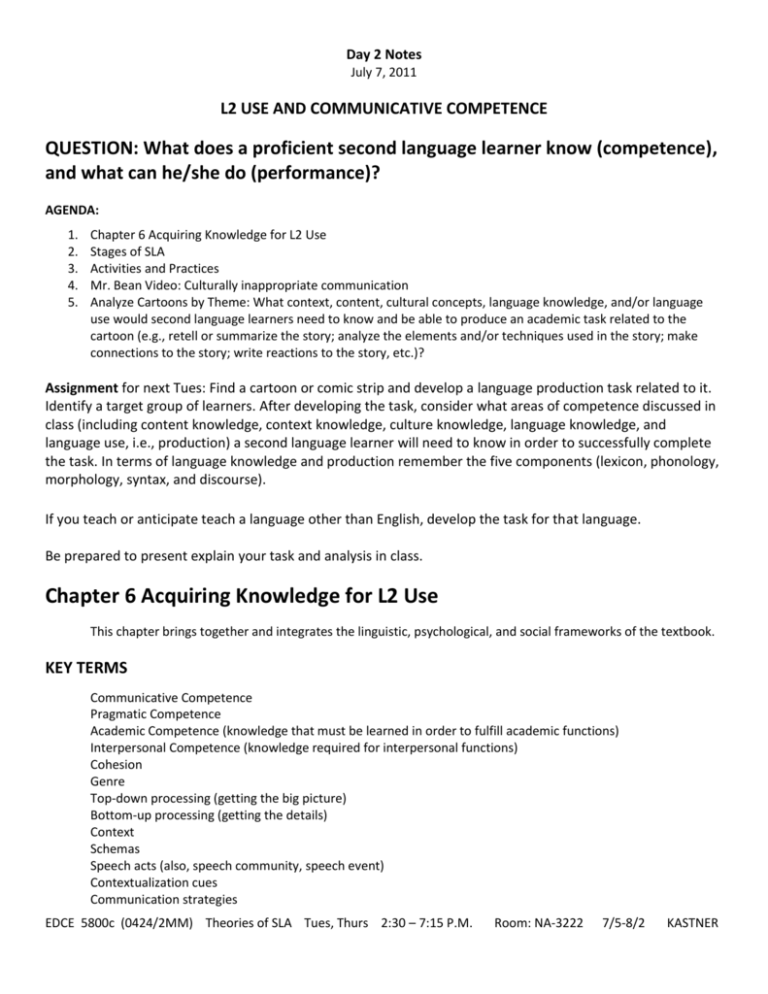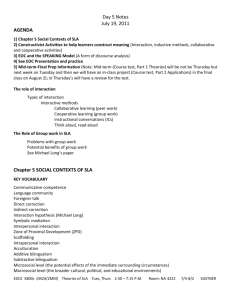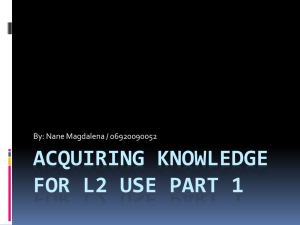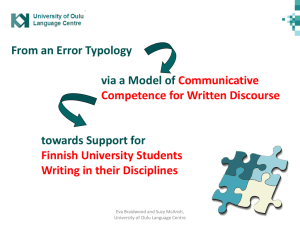Communicative Competence
advertisement

Day 2 Notes July 7, 2011 L2 USE AND COMMUNICATIVE COMPETENCE QUESTION: What does a proficient second language learner know (competence), and what can he/she do (performance)? AGENDA: 1. 2. 3. 4. 5. Chapter 6 Acquiring Knowledge for L2 Use Stages of SLA Activities and Practices Mr. Bean Video: Culturally inappropriate communication Analyze Cartoons by Theme: What context, content, cultural concepts, language knowledge, and/or language use would second language learners need to know and be able to produce an academic task related to the cartoon (e.g., retell or summarize the story; analyze the elements and/or techniques used in the story; make connections to the story; write reactions to the story, etc.)? Assignment for next Tues: Find a cartoon or comic strip and develop a language production task related to it. Identify a target group of learners. After developing the task, consider what areas of competence discussed in class (including content knowledge, context knowledge, culture knowledge, language knowledge, and language use, i.e., production) a second language learner will need to know in order to successfully complete the task. In terms of language knowledge and production remember the five components (lexicon, phonology, morphology, syntax, and discourse). If you teach or anticipate teach a language other than English, develop the task for that language. Be prepared to present explain your task and analysis in class. Chapter 6 Acquiring Knowledge for L2 Use This chapter brings together and integrates the linguistic, psychological, and social frameworks of the textbook. KEY TERMS Communicative Competence Pragmatic Competence Academic Competence (knowledge that must be learned in order to fulfill academic functions) Interpersonal Competence (knowledge required for interpersonal functions) Cohesion Genre Top-down processing (getting the big picture) Bottom-up processing (getting the details) Context Schemas Speech acts (also, speech community, speech event) Contextualization cues Communication strategies EDCE 5800c (0424/2MM) Theories of SLA Tues, Thurs 2:30 – 7:15 P.M. Room: NA-3222 7/5-8/2 KASTNER Pragmatic competence (Language use in social contexts): Consider the following sentences. What could they mean? “She is off today.” “What’s up?” “We have the best dogs in town.” Speech communities are groups of people who share similar values and codes of language use in specific social contexts. Scripts Registers Styles Culturally shared codes and socially expected communicative behaviors. Communicative Competence Model (Canale and Swain, 1983) Grammatical competence (sentence level, syntax, word order, etc.) Discourse competence (beyond the sentence level and stringing sentences together cohesively) Sociolinguistic competence (pragmatic competence, i.e., language use in social contexts) Strategic competence (using communication and other strategies to communicate meaning) Discourse Analysis of ELA Genres Differences Between Fiction and Non-Fiction Purpose Orientation Organization/Structure Analysis Language Use Fiction To inspire, to entertain Imagination, fantasy, subjective Rising-falling action, poetry Literary elements More figurative language Non-Fiction To inform, to persuade Real-world, objective Linear, intro, body, conclusion Facts, details, data, 5Ws More literal language, reported speech COMPETENCE AND USE Communicative competence = linguistic competence and pragmatic competence Cultural knowledge concerning the content of what is written or talked about, and recognizing the social significance of the context within which language use takes place. Knowledge of culture includes content, context, and linguistic elements in important respects, as well as understanding of the wider societal structures and practices that influence norms and conventions of language interpretation and usage. The ability to use language appropriately includes pragmatics (pragmatic competence), the knowledge and skills to interpret and convey meaning within communicative situations. EDCE 5800c (0424/2MM) Theories of SLA Tues, Thurs 2:30 – 7:15 P.M. Room: NA-3222 7/5-8/2 KASTNER The relationship of knowledge among domains of content, context, culture, language form and structure, and language use is dynamic, interactive, and constitutive. ACADEMIC vs. INTERPERSONAL COMPETENCE Repertoires of knowledge for many purposes within the native language community Priorities for L2 Use Academic competence (learn subject or as a tool in scholarly research, or as a medium in a specific career field) Interpersonal competence (primarily face-to-face contact with other speakers) Priorities for L2 Activities See text page 136 Academic Competence 1. 2. 3. 4. Reading Listening Writing Speaking Interpersonal Competence 1. Listening 2. Speaking 3. Reading 4. Writing Receptive skills = listening and reading Productive skills = Speaking and writing FIVE COMPONENTS OF LANGUAGE KNOWLEDGE Lexicon Morphology Phonology Syntax Discourse = vocabulary = word structure = sound system = grammar = ways to connect sentences to convey meaning and organize information Registers (varieties of language) used by specific groups in particular social settings Styles formal, colloquial, standard, non-standard, slang, etc. (ranges of language use) EDCE 5800c (0424/2MM) Theories of SLA Tues, Thurs 2:30 – 7:15 P.M. Room: NA-3222 7/5-8/2 KASTNER Vocabulary = function words, content words, frequency words, sight words, parts of speech (nouns, verbs, adjectives, pronouns, adverbs, prepositions, conjunctions, collocations, idioms, figurative language (simile, metaphor, personification, hyperbole, pun, onomatopoeia, etc.), connotative, denotative meanings Morphology = affixes, prefixes, suffixes Phonology = the sound system, phonemes, patterns, suprasegmentals (tone, stress, unstressed syllables), voice onset time (VOT) Individual, sociolinguistic, and sociocultural factors can also have a major impact on L2 phonology. Syntax (grammar) = Depending on the theoretical linguistic perspective one takes, acquiring the syntax of another language may be seen as an issue of internalizing new construction patterns, generative rules, different parameters for innate principles, or collocation probabilities and constraints. Because many of the grammatical structures common to interpersonal communication are different from those found in written academic text, even the development of considerable fluency for everyday interactive purposes does not guarantee that a learner will acquire the syntactic knowledge that is necessary for advanced literacy that full academic competence requires. Discourse = Linguistic elements at the level of discourse function beyond the scope of a single sentence. At a microstructural discourse level these include sequential indicators, logical connectors, and other devices to create cohesion. At a macrostrucural discourse level we go beyond linguistic elements to knowledge of organizational features that are characteristic of particular genres. EDCE 5800c (0424/2MM) Theories of SLA Tues, Thurs 2:30 – 7:15 P.M. Room: NA-3222 7/5-8/2 KASTNER Cohesion devices link one element of discourse to another, integrating them into unified text. They include many of the sequential indicators and logical connectors listed above, but also such ties as pronominal and lexical reference, substitution, and ellipsis (leaving out word or words). Both academic and interpersonal domains involve conventionalized categories and types of discourse, called genres. Academic genres Genres are “conventionalized” categories of discourse in the sense that knowledge of their nature and regularities is shared by members of a language community as part of the cultural component of communicative competence. For example, academic research reports that are written in English commonly follow the following sequence (See Swales 1990): (1) (2) (3) (4) (5) (6) (7) Statement of the problem under investigation and its potential significance Specific research question Review of related research Description of data collection and analytic procedures Presentation of findings Discussion of results Conclusion (often including mention of limitations and suggestions for further research) There is a variety in the patterns by discipline (e.g., academic reports differ somewhat depending on subject area) Contrastive rhetoric is an area of research that compares genre-specific conventions in different languages and cultures. Intercultural Communication Turn-taking rules may be universal, maybe not Transfer of politeness and turn-taking conventions from L1 to L2 RECEPTIVE ACTIVITIES -does not imply passive. Both receptive and productive skills require active participation/processes EDCE 5800c (0424/2MM) Theories of SLA Tues, Thurs 2:30 – 7:15 P.M. Room: NA-3222 7/5-8/2 KASTNER Bottom-up Processing (the big picture): Requires prior of the language system and interpretation of physical cues. Top-down processing (the details): Can compensate for linguistic limitations to some extent by allowing learners to guess the meaning of words they have not encountered before, and to make sense out of larger chunks of written and oral text. Top-down processing utilizes prior knowledge of content, context, and culture. Schemas (mental structures) Reading decoding Grabe (1991) reviews research on fluent academic in terms of six component abilities and types of knowledge: (1) (2) (3) (4) (5) (6) Automatic recognition ability Vocabulary and structure knowledge Formal discourse structure knowledge Content/world background knowledge Synthesis and evaluation processes/strategies Metacognitive knowledge and comprehension monitoring Orthography (the symbolic writing system) Grabe (2002) lists the following functions for reading in academic settings: Reading to find information Reading for general understanding Reading to learn Reading to critique and evaluate Stages in L2 Reading Advanced reading ability in both L1 and L2 is usually required to extract detailed information from text on science, technology, and other subject matter involving both linguistic and non-linguistic prerequisite knowledge. Prerequisite L2 knowledge includes: EDCE 5800c (0424/2MM) Theories of SLA Tues, Thurs 2:30 – 7:15 P.M. Room: NA-3222 7/5-8/2 KASTNER A large recognition of both basic and subject-specific terms, including their meaning, graphic representation, and probability of occurrence with other lexical items (e.g., colocations) Complex sentence structures, along with punctuation conventions that contribute to syntactic processing Organization features at the sentence level which identify Listening Listening accounts for most of the language input for L1 acquisition by children, but L2 learners often has much less opportunity to hear the target language and therefore receive much proportionally less input via this channel. Listening is a critically important activity, however, both for learners who want or need to participate in oral interpersonal communication and for learners who want or need to receive information from such oral sources such as lectures and media broadcasts. Reciprocal and non-reciprocal communication: Reciprocal communication requires learners to speak as well as listen, and to collaborate in the negotiation of meaning. Beginning L2 Listening Recognizing patterns in recurring sequences of sounds and attaching meaning to them. Segmenting speech requires not only perceiving sound, but noticing patterns in relation to a context which allows interpretation. Beginning L2 learners can begin to create sense from auditory input more easily if: They know in advance what the speaker is going to talk about Key words and phrases are learned as recognition vocabulary elements before they are encountered in connected speech Speakers pause frequently at boundaries between parts of sentences Auditory messages are supported by visual images (including writing) The communicative situation is a reciprocal one that allows the listener to seek repetition and clarification, or to ask the speaker to slow down Automatization Academic Listening Academic listening requires much of the same L2 linguistic knowledge as was listed for academic reading: A large recognition vocabulary of both basic and subject-specific terms Complex sentence structure Organizational features at sentence and discourse levels that distinguish new from old information and highlight important content Productive Activities Productive activities for language use involve essentially the same top-down and bottom-up processes as those for reception. Writing and speaking differ from reading and listening in referring primarily to constructing one’s own linguistic forms rather than interpreting what others write or say. EDCE 5800c (0424/2MM) Theories of SLA Tues, Thurs 2:30 – 7:15 P.M. Room: NA-3222 7/5-8/2 KASTNER Writing Writing is the most important productive activity for L2 learners to develop if they will use language for academic purposes. Many professions and occupations also requires a high level of L2 proficiency in writing of formal correspondence. “Information processing” and “output” facilitate SLA in several ways (e.g., Swain and Lapkin, 1995): Generating input Enhancing fluency by furthering development of automaticity through practice Helping learners notice gaps in their own knowledge as they are forced to visibly encode concepts in L2 forms, which may lead them to give more attention to relevant information Allowing learners to test hypotheses they have formulated as part of their developing linguistic systems (interlanguage), with opportunity for monitoring and revision Providing opportunities for others to comment on problems and give corrective feedback The need for interaction with other domains of communicative competence with language knowledge is evident when we consider some of the steps that are involved in proficient writing: Formulating mental concepts that are to be expressed centrally requires content knowledge Recognizing what content will be relevant for intended readers, and what will be shared versus new information requires context knowledge Constructing text within socially defined conventions of expression (including selecting linguistic forms and organization patterns that are appropriate for the topic, purpose, and audience) also requires other aspects of culture knowledge. Beginning L2 Writing Encoding, extensive practice, automaticity, copying, tracing, recording graphically something heard spoken (dictation), etc. Transfer from L1 Academic Writing Effective academic writing requires considerable knowledge of linguistic elements at levels of vocabulary, morphology, and syntax, mechanics of orthographic representation and punctuation, and conventions related to style and organization of presentation that are appropriate for the target genre. Command of formal register Language functions The relatively formal register need for most academic writing may conflict with the relatively informal register that is often emphasized in “communicative “ language teaching (CLT). Speaking The language knowledge involved in bottom-up processes for speech production include appropriate vocabulary, features of pronunciation, grammatical patterns that will convey meaning, and understanding of discourse structures that will provide cohesion and coherence within a conversation or other spoken communicative event. The top-down processes simultaneously involved in speech production require content knowledge about a topic, cultural knowledge that informs determination of properties and provides macrosocial context for expression, and knowledge of microsocial context such as the significance of the immediate communicative activity, speaker EDCE 5800c (0424/2MM) Theories of SLA Tues, Thurs 2:30 – 7:15 P.M. Room: NA-3222 7/5-8/2 KASTNER role and relationship to addressees, and appropriateness conditions (e.g., what must be said, what may be said, and what should be left unsais.) Fluency and accuracy Speech Acts Language functions are achieved through speech acts. Pragmatic Competence: Learning how to perform these acts in the L2 is central to language learning, and knowing when to deploy them is basic to what is known as pragmatic competence. A variety of linguistic forms may be selected to accomplish any one speaker goal, with appropriate choice for a particular situation requiring cultural and contextual knowledge. Appropriate selection from among the possibilities depends on the relative social status of the speaker and addressee, the closeness or distance of their relationship, and the degree of imposition the request involves. Other Aspects of Speaking Competence Knowledge of conversational structure (e.g., rules of turn taking, interruptions, overlaps, and simultaneous speaking; back-channel signals (verbal and non-verbal) Knowledge of contextualization cues Knowledge of pronunciation strategies Knowledge of communication strategies Scaffolding Differentiated instruction EDCE 5800c (0424/2MM) Theories of SLA Tues, Thurs 2:30 – 7:15 P.M. Room: NA-3222 7/5-8/2 KASTNER








